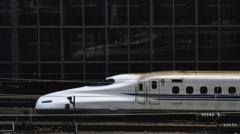The Hatsushima train station showcases rapid construction methods that could reshape the future of public transport in Japan.
Japan Unveils World’s First 3D-Printed Train Station in Just 6 Hours

Japan Unveils World’s First 3D-Printed Train Station in Just 6 Hours
Innovative technology addresses infrastructure challenges in rural areas as population declines.
The newly inaugurated Hatsushima train station, located in the seaside town of Arida, Japan, stands as a testament to modern engineering, having been completed in a remarkable six hours. This revolutionary project replaces an older wooden structure that had served the community for over 75 years. The station’s components were manufactured using 3D-printing technology at a separate facility, then shipped and assembled on-site, marking a significant milestone in construction methods and railway infrastructure.
As Japan grapples with an aging population and declining workforce, maintaining transportation services, particularly in rural areas, is becoming increasingly challenging. The West Japan Railway Company claims this project is a world first, proving that advanced construction techniques can effectively address logistical hurdles in remote communities.
The Hatsushima station is situated in Arida, a city with a modest population of 25,000, nestled near popular tourist spots in Osaka and Nara. With trains operating at intervals of one to three times per hour, the station serves roughly 530 daily commuters. Among them is Yui Nishino, a university student who expresses her amazement at the speed of the construction: “I hope they can make more buildings with 3D-printing technology,” she remarked after witnessing the rapid assembly.
This innovative approach not only cuts construction time significantly but also reduces costs, with the entire project completed at half the expense of traditional building methods. As rural stations face declining usage, such advancements could play a crucial role in ensuring that essential infrastructure remains intact, even as demographics shift.
As Japan grapples with an aging population and declining workforce, maintaining transportation services, particularly in rural areas, is becoming increasingly challenging. The West Japan Railway Company claims this project is a world first, proving that advanced construction techniques can effectively address logistical hurdles in remote communities.
The Hatsushima station is situated in Arida, a city with a modest population of 25,000, nestled near popular tourist spots in Osaka and Nara. With trains operating at intervals of one to three times per hour, the station serves roughly 530 daily commuters. Among them is Yui Nishino, a university student who expresses her amazement at the speed of the construction: “I hope they can make more buildings with 3D-printing technology,” she remarked after witnessing the rapid assembly.
This innovative approach not only cuts construction time significantly but also reduces costs, with the entire project completed at half the expense of traditional building methods. As rural stations face declining usage, such advancements could play a crucial role in ensuring that essential infrastructure remains intact, even as demographics shift.






















